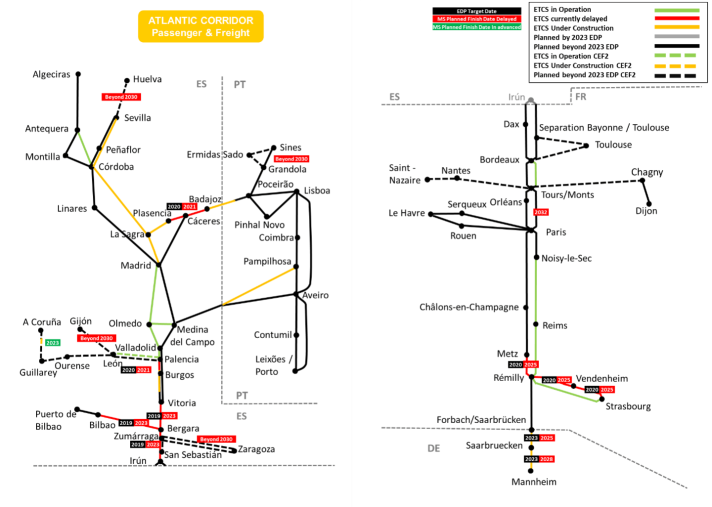Corridor description
The total length of the Atlantic corridor (ATL) is 11 295 km long, including the Connecting Europe Facility 2 (CEF 2) extension. It crosses four countries: Spain, Portugal, France and Germany. Some ports and airports in Ireland are also part of the ATL, however, the railway connections are not included in the ATL.
The ATL CNC (Core Network Corridor) links the Western part of the Iberian Peninsula to France and Germany, with high-speed rail lines and parallel conventional ones, providing for the continuity of the networks between Lisbon, Madrid, Paris and Strasbourg, Mannheim and Le Havre.
ERTMS deployment on the corridor
The following image shows the state of play and deadlines for the ERTMS deployment in the ATL corridor, considering the dates of the European Development Plan (EDP):
Overall, ETCS is in operation on 11% of ATL, while GSM-R on 39% of the corridor. In March 2023, 60% of the ATL length planned in the EDP by 2023 was in operation with ETCS. According to the TEN-T Guidelines, 11 104 km are expected to be equipped by 2030.
The deployment status per Member State where the ATL corridor runs is as follows:
- In Portugal, no section is planned to be deployed by 2023 according to the EDP. The whole core network in Portugal is expected to be equipped by 2030 in line with the Portuguese deployment plan. The Grândola – Ermidas Sado – Sines line, added in the CEF 2 extension of ATL, is included in the Portuguese deployment plan for 2030. However, the commissioning of the new construction Grândola - Sines line will take place beyond 2030.
- In France, there are already some lines in operation on ATL. According to the French plans, the Metz – Rémilly – Strasbourg line planned in the EDP by 2020 will be postponed to 2025. Regarding sections planned in the EDP beyond 2023, French plans do not support those lines being in operation by 2030.
- In Germany, only one ATL line continues from the French border to Mannheim. According to the EDP, this line was expected for deployment by 2023, but it will be postponed to 2028 according to the latest German plans. In France, there are already some lines in operation on ATL.
- In Spain there are already some lines in operation on ATL. The Spanish sections next to the border with France and Portugal (Badajoz), planned in the EDP by 2019 and 2020, are postponed to 2026 and 2023 respectively. ATL sections are planned in the Spanish plan by 2030 except for 3 CEF 2 lines: Sevilla – Huelva, León – Gijón and one of the lines from Zumárraga to Zaragoza.

